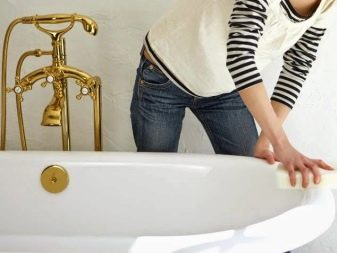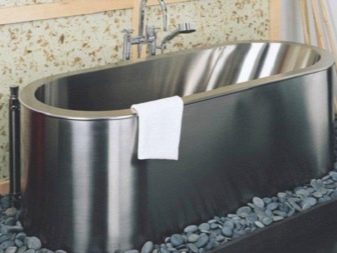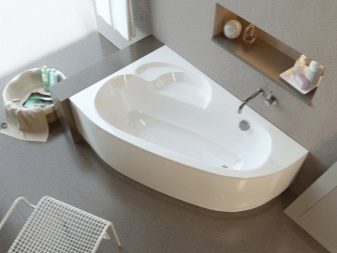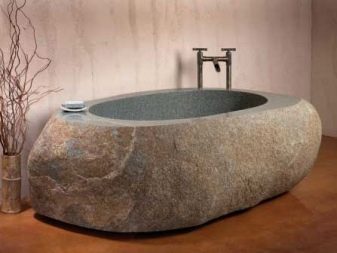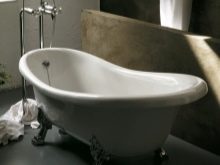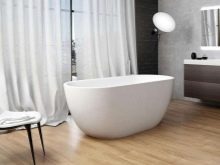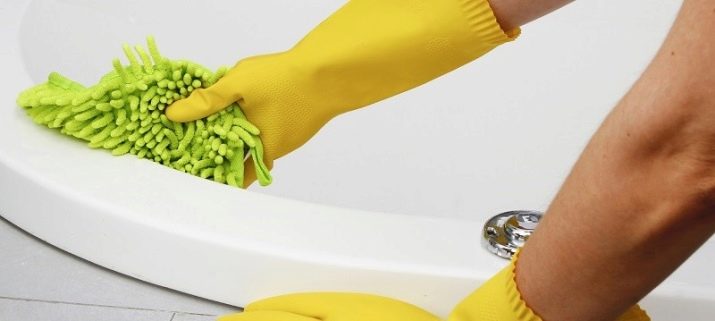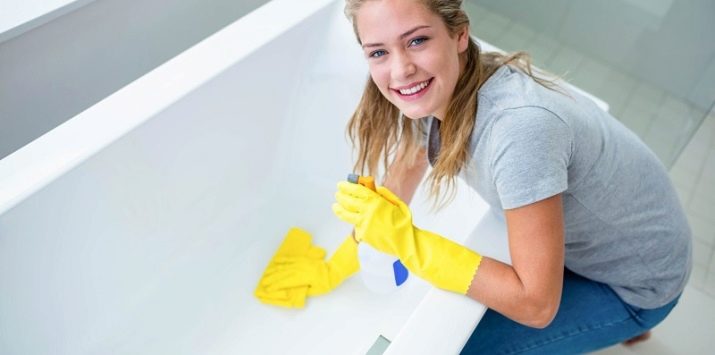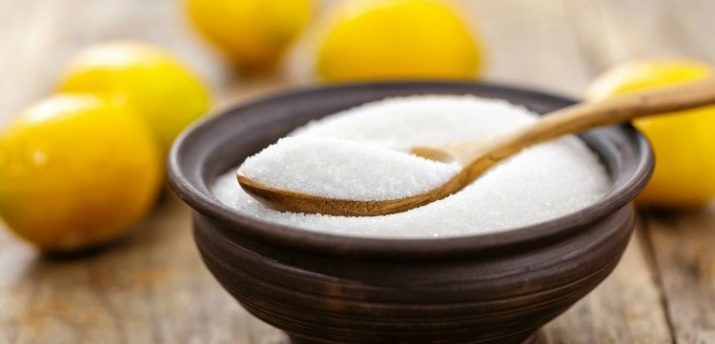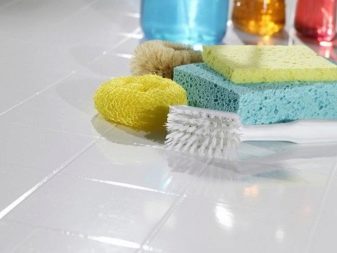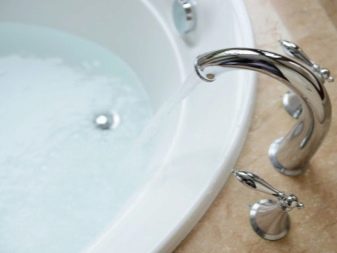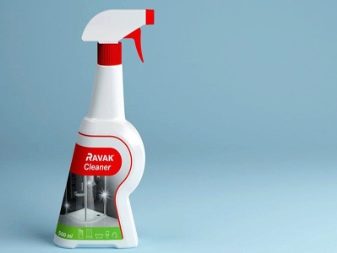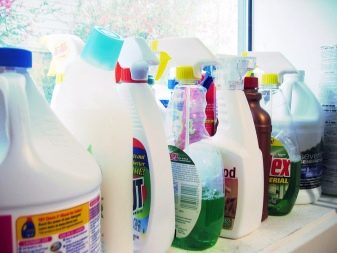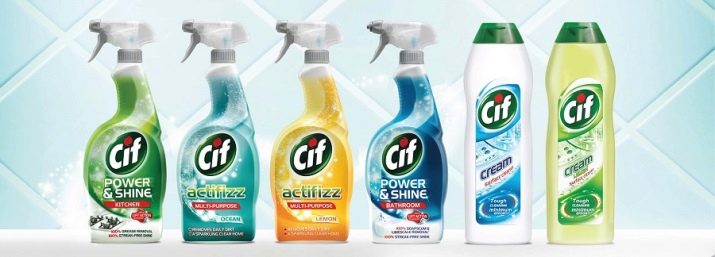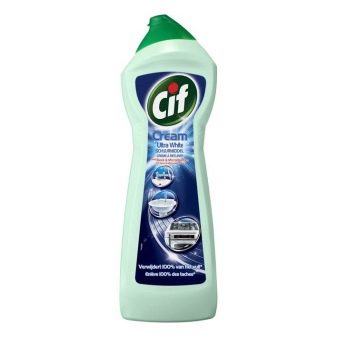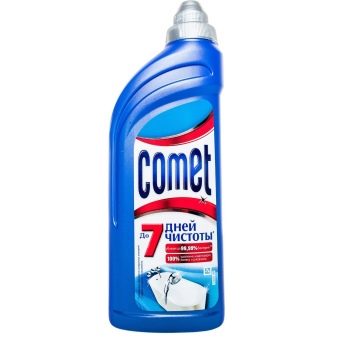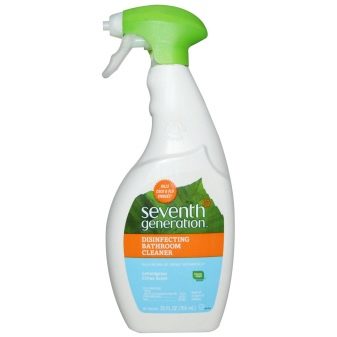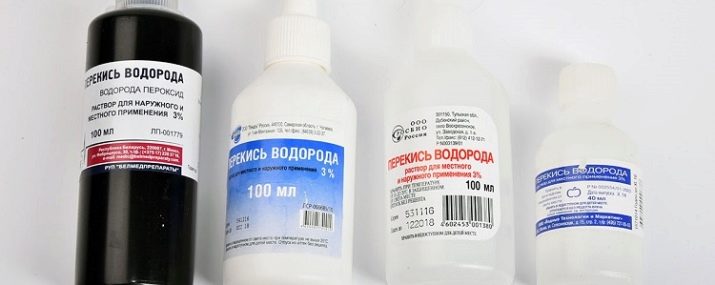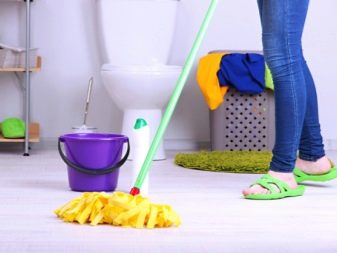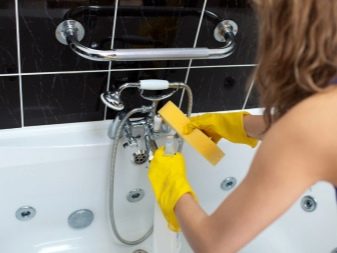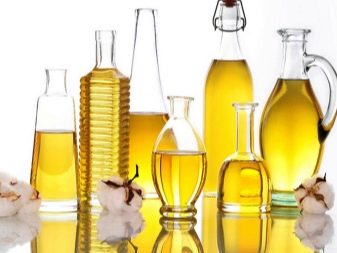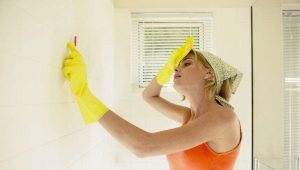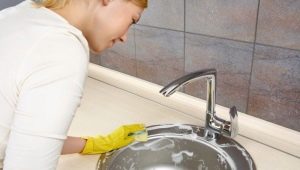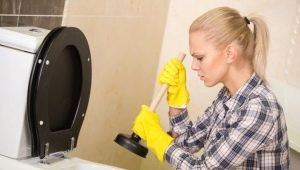How to clean the bath?

Every day even the best housewives face the need to clean, wash, scrub, or remove suddenly formed stains. This article will discuss the gradual cleaning of one of the main rooms in each house - the bathroom, and, in particular, the bathroom bowl itself.
Kinds
To begin, consider the main types of plumbing from various materials and their brief characteristics.
The following types of baths can be classified by production material:
- Cast iron. Bathrooms made of this material are durable, therefore cast iron bowls have the longest service life. They keep warm well and are resistant to high temperatures. It is very easy to take care of such fixtures, as the enamel coating does not contain pores and is resistant to many chemical influences. The only negative is that the enamel can crack under a strong blow, and in this case it will be difficult to restore it.
- Steel. This type of bath is strong enough, light in weight and resistant to the formation of pollution. The heat capacity is small. But on steel baths there are almost no stains from accidentally fallen cigarette ash or a lit match (which cannot be said about acrylic). Enamel in such baths does not turn yellow. The main disadvantage is the same as that of cast iron: enamel coating is not resistant to the blows of great strength.
- Acrylic. Polymeric material is characterized by high plasticity, with a sudden fall of the object the enamel will not crack. Also, on an acrylic surface with regular care, bacteria practically do not breed. The water in it remains warm for a very long time. It is enough to rinse the bathroom after each use, and it will always be clean. Disadvantages can occur only when improper use plumbing. It also does not withstand temperatures above 60 degrees.
- Cast and natural stone. Such baths made of artificial and natural stone are durable and long serve. They are resistant to chemical attack, but they can only be cleaned with soft sponges and soap. Also require careful handling to prevent scratching.
- Ceramic Baths are durable, resistant to scratching, bacteria and stains. They are easy to clean by any means, as the cermet coating is resistant to any chemical attack, including constant contact with tap water of poor quality. The most noticeable disadvantage is their fragility with improper and careless handling.
- Baths from modern materials (xonix, quarry) They have almost the same characteristics as acrylic and ceramic baths for the care of their surface.
- With hydro massage. Baths of this type are made from different materials. The massage effect is achieved with the help of nozzles, from which either air bubbles, water jets, or a combination of them enter the container.
Effective cleaning methods
Not always enough time and effort to monitor daily bath cleanliness. Often it is used for other purposes. It is used to wash, wash animals, soak underwear, wash shoes and large items. It should be noted that the cleaning of white-hot acrylic baths requires specially selected products due to the specific coating.
But first, consider all types and causes of pollution that may occur on a bathroom surface for a long time:
- Limescale. It occurs because of hard tap water, which contains salts of magnesium and calcium, - they, getting to the surface of the bath, form ugly whitish stains, depriving it of radiant shine. Therefore, this type of pollution is better to wash with acidic agents.
- Rust. Appears because of the high content of iron in water. Most often in places of constant contact with water - at the taps, drain holes and near them. Yellow rust stains are quite difficult to clean.
- Yellowness on the enamel of the bathroom and other bathroom items formed due to dirty pipeline. Flowing through it, the water carries a variety of acids, which are deposited on surfaces, forming a plaque.
- Special types of pollution. These pollution are the consequences of repair, careless handling of coloring agents: potassium permanganate, iodine, green paint, hair dye, coloring balms, blueberry juice. Also such types include smoldering cigarette ash and mold.
- Soap It is formed from constant contact with chemical compounds of soap, shampoos, shower gels.
- Plain. It is a combination of skin particles, fat, sweat and lather swept away from the human body and forms peculiar "flakes". It is easy to cope with such a bloom if you regularly, after each wash, clean the bathroom with a warm shower jet and a soft cloth with a small amount of dishwashing detergent or soap.
- Old enamel surface. Such enamel is covered with microcracks, in which various impurities constantly fall, which makes the bath look untidy. In this case, to wash the bath will not be easy, but possible.
If all household chemicals in the house have run out, ordinary citric acid can be used to speed up the cleaning of the container. The process itself will take about half an hour. This is the holding time of the product on the surface of the bath.
To prepare it in an enamel or plastic container, you need to mix two tablespoons of dry citric acid crystals (approximately one bag), which any hostess has, and water of 0.5 liters. Then apply the solution with a soft sponge over the entire surface, after closing the drain device. Hands must be protected with gloves. You can also impose a bath impregnated in acid solution wipes. When the exposure time has passed, just rinse it with water. Citric acid well removes yellow and limescale. If necessary, the procedure can be repeated as many times as necessary.
If the bath is very dirty, then wash it quickly to a snow-white state at home is also possible. But this will require a little more time, because the work will have to be carried out in several stages.
First you need to prepare a special mush. To do this, mix ordinary baking and soda ash in equal proportions. Then dilute the mixture with a small amount of water to form a semi-liquid paste. Baking soda is in every kitchen, and soda ash can be purchased at a hardware store or household chemicals department. This is the simplest cleaning agent.
Then it is necessary to moisten the walls and bottom of the bath with water and evenly apply the prepared composition using a soft sponge. After 10 minutes, without washing anything, apply a mixture of vinegar and bleach. These ingredients are also taken in equal proportions. Vinegar can take the most common, table, 9%. Bleach - “Persol”, Ace, “Bos”, “Whiteness”, Vanish and other powdered bleachers, which can be purchased at any store at a small price. Leave for half an hour.
Then, using a sponge, wipe the entire bath and rinse thoroughly with water. When working with vinegar, it is better to protect the face with a cotton-gauze bandage. After this cleaning, even the dirtiest bath will shine clean.
Acrylic
The material from which these baths are made is a plastic polymer. In essence, it is a plastic with considerable hardness.Acrylic has a wide range of uses, including its use for the manufacture of baths.
Advantages of acrylic baths:
- relatively low price;
- high heat capacity;
- non-slip surface;
- some models are available with anti-slip coating (anti-slip);
- resistance to strong shocks;
- hygiene;
- ease of daily care;
- the possibility of restoration with their own hands;
- diverse design.
Minuses:
- instability to chemical and high temperature effects;
- scratches appear on any hard objects.
You should also consider the fact that Not every acrylic bath offered in stores at a low price will have all the advantages described for use. It may be just plastic or very poor quality acrylic, which will fade after a week of active use.
Based on the above characteristics, we can conclude that acrylic baths need special and thorough care. They are sensitive to any aggressive chemical agents, so for their cleaning you can only use special cleaners that do not contain chlorine, acids, alkalis, alcohols, ammonia, formaldehyde, powder granules.
After each wash, wipe the entire surface dry. Cleaning the bath with the use of special creamy household chemicals can be no more than once every 2 weeks.
The maximum comfortable temperature - about 45 degrees, at a water temperature of 50-60 degrees and above the wall and the bottom of the bath can be deformed.
From the mass market, you can use sprays and mild detergents for washing, polishing, cleaning from rust, water stone, hygienic treatment. You can also find and universal tools that combine components that combat all types of pollution, for example:
- Ravak. The range of Czech-German broad-spectrum aids. It will help to wash the grease, water stone and especially strong pollution, without damaging the acrylic. This is not a cheap import tool.
- Triton Acrylic cleaner. A relatively new tool for acrylic, plastic and chrome surfaces from the domestic manufacturer. The composition includes water, PVA 5%, organic acids, antiseptics. Deletes fat, a limy raid, a rust. After applying the bath will shine. It is easily sprayed on the surface of the bath, leave the agent for 10 minutes, then rinse with a sponge. The cost is average.
- "Acrylan". The product includes citric acid and surface-active chemicals (surfactants), which are not harmful to the acrylic surface. It has a cleaning and disinfecting action. Also suitable for sanitary ceramics, bathroom tiles and glass. It has a convenient spray that allows you to spray and foam, and liquid jets. The tool is fast-acting, it should be washed off almost immediately after application. It must not be left to dry completely. It forms a protective film on acrylic, which prevents the formation of plaque and rust. Of the minuses of the tool, you can note its unpleasant smell and relatively high price.
- Cif. Cheap affordable creamy tool that is suitable for acrylic. The composition does not have strong abrasive components, easy to use, cleans various surfaces. Of the minuses - does not remove persistent pollution.
- Bass Disinfectant and cleansing agent in the form of a gel. In the composition - weak acids, therefore for a long time it is better not to leave the agent on the surface. It can be used only on problem areas, wiping with a soft sponge after application, then rinse with water.
- Frosch. Natural remedy based on grape acid, which can be sprayed onto the surface of the bath, while protecting hands with gloves. The exposure time is from 10 to 20 minutes depending on the pollution. Suitable for families with children and allergies.
- Mr. Chister. The composition includes nonionic surfactants 5%, citric acid, antibacterial components, acrylic copolymer, sodium citrate.Spray dispenser bottle. The maximum exposure time - 2-3 minutes, after you need to wipe with a soft cloth and wash off with plenty of water. Of the minuses - a pungent smell. You also need to work, protecting hands.
- L. O. C. Amway. The tool does not contain abrasives, as part of no acids and chlorine, so it is suitable for people with a chemical allergy. The tool copes well with pollution, economically consumed. Of the minuses - the price is quite high.
- Folk remedies. Acrylic baths can be washed using vinegar or citric acid. But the concentration should be very small. It is better to fill the bath and dissolve in it a small amount of vinegar or citric acid and leave for 10-12 hours. Vinegar concentration 1: 50 or 0.5: 50. Then drain the water and rinse the bath with water, then wipe dry.
You can also simply wipe the surface with lemon juice or make a “cream” at home by mixing soap chips swollen with water with a small amount of soda and a drop of essential oil.
When cleaning acrylic baths, you should not use hard and especially metal sponges, brushes with artificial bristles and any abrasive materials.
You can not soak clothes in acrylic baths, as hard parts can damage it, and bright fabrics can shed and paint the surface. If it is necessary to wash by hand, you need to put a rubber or silicone pad on the bottom of the tub that will not allow the pelvis to scratch the bottom. You can not bathe animals for the same reasons - the surface may be damaged by their claws.
If scratches and patina still appear and cannot be polished with felt, you can purchase special liquid acrylic for repair with your own hands. This acrylic can be purchased in a special set for the restoration of acrylic bath coatings. Instructions are attached to it. The substance is applied to the surface of the bath, evenly distributed, after some time, the process of polishing by hand.
Cast iron and steel
Enameled coating of cast iron and steel baths is a material that includes glass. Such surfaces tolerate an alkaline environment worse than a solution of weak acids. Therefore, if the enamel of the bath has faded, the care product has been chosen incorrectly.
Iron and steel containers, as well as acrylic, need to be washed after each use, and then wipe dry to keep the surface smooth and shiny. If there is no strong pollution, it is enough to simply rinse the surface with warm water from the shower.
It should be noted that old and new baths are not recommended to be cleaned with chemistry with chlorine, hard abrasives and acids; also, it should not be washed with compositions that are produced for sanitary facilities.
Traditional methods of cleaning at home were discussed above, and as for the mass market, you can select soft remedies for periodic cleaning and those that contain chemically active ingredients to remove stubborn dirt. Among them are:
- "Sanox Gel" company "Stork" - it contains oxalic acid, so they can scrub the most old rust spots, but it cannot be used regularly, as this acid spoils the enamel over time.
- Cillit bang - means for regular washing of a bath, but it is better to fight with water stone and rust in other ways.
- Cif "Ultra White" - gel means for cleaning and bleaching.
- Comet "7 days of purity" - a universal gel for the bath, plumbing and kitchen. Removes heavy dirt.
- "Pemolyuks soda 5". Proven product of soda and marble chips, suitable for old cast iron baths.
With hydro massage
Such baths are most often made of acrylic, it is more plastic and cheaper than artificial and natural stone.
A special pump pumps water from the bath, then it passes through nozzles (jets), round holes on the surface, and again jets out, creating a massage effect.Jets over time accumulate bacteria and mold.
It is enough to regularly wash the container with special products without abrasives that are suitable for acrylic. It is also necessary to clean the entire whirl system regularly after each wash. Automatic disinfection is not present in all baths, so the dirt nozzles need to be cleaned on their own.. To do this, pour a full bath of water and pour disinfectant into it, then turn on the system. After some time required for cleaning, you need to turn it off, drain the water. Then re-enter the bath and turn on the hydromassage for 5-10 minutes to wash off the remnants of the product.
If the system is still contaminated, it can be cleaned in the same way with the addition of a tablet-cleaner for the dishwasher, along with a disinfector.
Home remedies and compositions
If there is enough time to clean the bath, you can use one of the many different folk remedies. The choice of the method and means of cleaning the bath should be determined by the type of stain or bloom, the degree of contamination and the material from which its bowl is made.
Fixed assets from stubborn dirt that are in every home:
- soda (food and soda);
- vinegar;
- lemon acid;
- salt;
- laundry soap;
- ammonia (adds shine to enamelled surfaces);
- dishwashing liquid;
- hydrogen peroxide;
- cream of tartar;
- Coca-Cola.
To make the bath sparkle, you can clean it with a single vinegar, moistening it with pre-napkins. They should be laid out on the surface of the bath and left for several hours. This method is suitable for relatively new baths. Enamel will be much whiter.
It is also recommended after this procedure to treat the container with soda solution to restore the acid-base balance.
Rusty spots and yellow patina can be removed with a mixture of wine vinegar and coarse edible salt. To do this, mix 100 milliliters of vinegar and a tablespoon of salt. Heat the mixture to 65 degrees and put it on the spot, leave for 20-30 minutes. Then rinse with water. Table salt can be used in combination with turpentine. The mixture does not need to be heated. Just apply for 20-30 minutes on a rusty surface, then rinse with water.
Also, stains with a steady rust can be cleaned with hydrogen peroxide. This liquid has no color, and the peroxides contained in it do an excellent job with a yellow patina.
To effectively remove limescale and give shine to the surface, you need to mix 150 milliliters of ammonia and 50 milliliters of hydrogen peroxide. In a glass container, this mixture should be left for 10 minutes. Next, moisten the sponge with a product and intensively wipe the entire bath using gloves and a bandage for the face. Then rinse with a stream of water. This composition will give the bath a radiant shine.
Ginger spots can be removed with a mixture of tartar, hydrogen peroxide and any mild detergent. Tartar is used in cooking for baking and mousse, and the acidic potassium salt it contains is suitable for cleaning the bath. You need to take 300 grams of mild detergent, 70 milliliters of hydrogen peroxide and 5 grams of tartar. Mix point-to-point only places of strong pollution. Leave no more than 30 minutes. This tool is best kept at a low temperature in an airtight container.
A solution of soap and a few milliliters of ammonia will help to wash all kinds of stains. Also, soap shavings dissolved in water can be used with soda to remove limescale.
Coca-Cola contains carbonic acid. This drink has no unpleasant smell and does not irritate the skin, therefore, it is not necessary to protect hands and face. Coca-Cola helps to cope with lime deposits, remove rust from the surface of the sink, bathtub, bathroom and tile, as well as the mixer and faucets. It is very easy to make - you need to dampen a soft cloth or sponge with this drink and wipe the surface.If necessary, repeat the procedure. A raid from the bathroom can be cleaned like this: pour the drink inside and close the toilet lid on top. After an hour, simply clean it with a brush.
The rust bath can be cleaned with towels moistened with sparkling water. They need to expand on the ground rust and leave for two hours, occasionally additionally wetting the fabric with a drink. Also, Coca-Cola can be used to prevent blockages in the pipeline.
Useful tips if unexpected contamination occurs:
- Potassium permanganate from the bath can be effectively washed with citric, acetic or oxalic acid at a concentration of 10%. Care must be taken. Stain from potassium permanganate is filled with a solution for 5 minutes, then the place is thoroughly washed with water. Also suitable peroxide with acetic acid. You need to mix them, put on cotton wool and rub the stain. This tool also removes old stains.
- From the blueberry bath enamel, you can try to clean the bleach, mixed with detergent, which is applied to the sponge and rubbed into the stain, then washed off with water.
Features room cleaning
Having coped with cleaning the bath, you can proceed to the rest of the plumbing and accessories. Polyester bath curtain should be washed regularly. It is necessary to erase them on the delicate mode in the washing machine without spinning. Then they can be dried by hanging in the bathroom.
Glass surfaces should be cleaned with special sprays that will remove grease and deposits. Then wipe thoroughly with a dry newspaper / paper.
Ceramic tiles can be cleaned with a solution of vinegar and water, then rub the grooves with chalk. The second option is to wipe with a damp cloth, which is filled with soda and crumbled chalk.
The tile is better washed with a brush with natural soft bristles. A matte floor tile with an anti-slip coating is cleaned with special emulsion agents, and then rubbed with a means to maintain color, and glossy tiles should be wiped with vinegar or ammonia for shine and brightness.
Nickel-plated faucets and surfaces from stains can be cleaned by wiping them with a weak solution of citric acid or just a lemon peel.
After the walls and floor have been cleaned, they should also be wiped dry with a microfiber cloth, a towel with lint-free nap or a bamboo cloth.
The ceiling in the bathroom can be cleaned with a vacuum cleaner or mop. If it is tensioned and consists of plastic panels, then to wash it, It is not recommended to use abrasive sponges and acetone-based products, otherwise the surface will become dull, and there will be stains.
You need to wash the plastic ceiling on a stable stepladder or platform. You will also need a mop for cleaning windows, a spray for cleaning glass surfaces, a dry absorbent rag, a soft sponge and a water tank. First, use a mop to clean the ceiling of dust, then moisten the surface with warm soapy water or spray and gently scrub all dirt, preventing the ceiling from drying out. Then dry and wipe away the moisture in the corners with a dry sponge.
If the ceiling panels are very dirty, you need to dismantle the entire structure and wash each panel separately, and then wash the frame, the floor slab. Upon completion, everything is set in place.
How to wash after repair?
When installing a new bath, you can immediately install a special anti-limestone filter that will soften the water and prevent the formation of plaque.
It will be easier to wash the building dust if you add a few tablespoons of vegetable oil to a bucket of warm water. This will allow you to quickly collect cement dust, dirt and small debris. After that, you need to wash the walls, floor and ceiling with a cleaning agent, then rinse and wipe dry.
If there are any stains on the tile, you can scrub them with:
- large amounts of water;
- acetone, remover, then apply a fresh primer (if stains on the floor);
- rubber spatula or cloth (if the solution is fresh);
- epoxy solvent;
- solvent glue or water with vinegar or ammonia.
Paint stains on the tile can be washed with a solvent applied to a piece of cloth. It is put on the polluted place and covered with a film. Then, after about half an hour, the swollen remains are removed with a spatula or rubbed with a thick rubber sponge.
Faucets and mixers and showers can be washed with soap and water based on, for example, dishwashing gel. In no case can chrome-plated surfaces be washed with acid-based products - stains will appear, and plumbing will be damaged.
Strong paint stains can be removed from the bath surface by a mechanical method, such as a blade or a clerical knife, but this should be done very carefully so as not to scratch the metal.
Stains of glue can be removed by pouring hot water into the bath. It should be left in the bath for 24 hours, and then gently scrub the hard side of the sponge.
On how to clean the cast-iron bath from the raid at home, see the following video.
